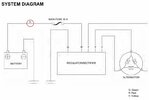spark82
Member
It's not out of the question, I looked at an animation of the NC engine (I tried to visualize it in my head and failedLong shot question: did you check the clearance of the exhaust valves? I know that it is not very probable, but one of the reasons for the resistance of the cylinder stroke would be that the exhaust valves would not open, e.g. due to a timing error (the chain could skip).
It is easy for me to come up with crazy theories when I am not seeing the patient.
I'm still at work, I'll check when I get home.



